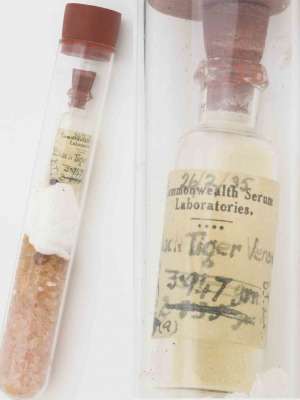Vintage venoms lose none of their bite

(Phys.org) —Venoms stored for up to 80 years remain biologically active, new research shows.
A University of Queensland professor says the venoms are a time-capsule of disappearing biodiversity and hold potential for the discovery of new medicines.
Associate Professor Bryan Fry led the study, which examined 52 venom samples – including rare and historically important venoms.
"The research shows that properly stored venoms remain scientifically useful for decades and that vintage venom collections may be of continuing value in toxin research," he said.
"Venoms and toxins are a rich source of unexplored compounds which could be used in drug discovery and development."
Snake venoms have been used to develop drugs such as Captopril, which is used to treat high blood pressure, and Byetta, which is used to treat diabetes and has off-label effectiveness as an anti-obesity drug.
"The venoms we studied came from the invaluable collection curated by the late Struan Sutherland, and it is a testament to his continuing impact upon venom research in Australia, long after his passing," said Dr Fry, who with a team of researchers has published a paper on the study today.
Dr Sutherland was head of Immunology Research at the Commonwealth Serum Laboratories for 28 years until 1994, and then founder of the Australian Venom Research Unit at the University of Melbourne. He died in 2002.
"The venoms of different species have extensive variation so each venom sample is a precious resource which could contain the next wonder-drug," said Dr Fry, who works in UQ's School of Biological Sciences.
"Storing these samples correctly is particularly important as many venomous snake species worldwide are declining and fresh venom may be difficult to come by.
"Some of the Australian venoms we studied may be the only samples ever collected from a range of unique island tiger snakes which are now threatened by habitat destruction."
Associate Professor Fry and his team also studied the first coastal taipan venom collected for antivenom research by Kevin Budden in 1950.
"It was such an honour to work with these samples due to their immense historical significance," he said.
"The young man who collected this venom was bitten in the process but heroically made sure the snake was transported away for research before he went to the hospital, where he died shortly after."
Venomous animals worldwide are disappearing due to habitat destruction, persecution from activities such as rattlesnake roundups, and the impact of feral animals such as cane toads.
Many venomous snakes have disappeared from large parts of their range or become extinct.
"Collected venoms are an important time-capsule which may one day be used for research, long after the animals themselves have become extinct," said Associate Professor Fry.
"As part of this project we studied death adder venoms from locations where the adders have been wiped out by cane toads.
"These collections may represent the last opportunity to discover the potential wonder-drugs hidden within the venoms of endangered species of snakes."
More information: The research paper, Vintage Venoms: Proteomic And Pharmacological Stability Of Snake Venoms Stored For Up To Eight Decades, was published today in the Journal of Proteomics.
Provided by University of Queensland


















